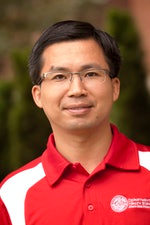Nutrient pollution is one of the most widespread, costly, and challenging environmental problems facing the U.S., according to the Environmental Protection Agency (EPA). Elevated levels of nutrients in water harm aquatic life and impact public health.
Senior Illinois State University environmental health and sustainability major Rowan Carroll is addressing the widespread issue through a process she’s developed that not only removes nitrogen and phosphorus from wastewater but also creates a fertilizer for agricultural use.
A 2020-2021 Undergraduate Research Support winner, Carroll will present her research project “Recovering Nutrients from Wastewater” during Illinois State’s annual University Research Symposium on Friday, April 1, in the Bone Student Center. The symposium, which is free and open to the public, is a university-wide showcase of scholarship, research, and creative achievement.
“The biggest reward for me would be if someone could use this, and it would improve people’s lives by making clean water more accessible.”
Senior environmental health and sustainability major Rowan Carroll
According to Carroll, agricultural runoff is a leading contributor to nutrient water pollution in the Midwest. “There is a high amount of nitrogen and phosphorus in fertilizers that farmers need,” Carroll said. “So, we’ve been trying to figure out a way in which they can still use the fertilizer, and we’ll still be able to reuse the water.”
Working alongside Associate Professor of Environmental Health and Sustainability Dr. LC Yang, Carroll began her research by testing an untreated effluent sample—a sludgy liquid that smells like sewage—taken from the Bloomington-Normal Water Reclamation District. As anticipated, the sample contained elevated levels of nitrogen and phosphorus.
After spending two weeks using a centrifuge in Yang’s Felmley Hall lab to separate the water from the sludge, Carroll added sodium hydroxide to manipulate the pH level along with magnesium chloride to produce struvite—a slow-release fertilizer containing the recovered nitrogen and phosphorus.
“It’s hard to remove liquids—nitrogen and phosphorus—from a liquid—water,” Carroll said. “So, the struvite that’s created when the magnesium chloride is introduced can be taken out of the water—and then, obviously, the water will get treated before being discharged. The main goal was just trying to make struvite—a solid—so that you’re able to remove it easily from the water.”
It took Carroll five months of experimentation in Yang’s lab to successfully create struvite while sufficiently lowering elevated nutrient levels. Throughout the process, she manipulated different variables including the pH level, the temperature, and the amount of time spent mixing magnesium chloride into the water. Carroll said, at times, it felt like nothing was going right.
“I kind of just realized I needed to slow down to prevent errors, because human error is a big thing in research—if you mess up even a little number that you mark down, you can get completely different results,” Carroll said. “I had to train myself to slow down and carefully look at what I’m calculating and how much of this or that I’m adding to the mixture.”
To achieve her intended results, Carroll ultimately determined that she needed to mix the solution, with a pH level of 10, for 60 minutes and let it rest for another 60 minutes at room temperature.
“When it finally started clicking into place, and I could actually see it all working out—that was definitely super rewarding,” Carroll said.
Carroll was introduced to environmental health by taking one of Yang’s classes as an elective. She enjoyed it so much that she switched her major and, in 2019, Carroll began strategizing a research project with Yang focused on wastewater treatment.
Yang said Carroll’s dedication to research is impressive and her findings are significant.
“Her work found an optimal reaction condition to convert two nutrients—nitrogen and phosphorus—in wastewater to struvite,” Yang said. “This will help control nutrients in runoff and wastewater, which is very important in the Midwest region.”
A scaled-up version of Carroll’s method would require a water reclamation plant to utilize an industrial-sized mixer and develop a process for extracting and distributing the struvite fertilizer.
“I think this has the possibility to help improve access to clean water,” Carroll said. “The biggest reward for me would be if someone could use this, and it would improve people’s lives by making clean water more accessible.”


